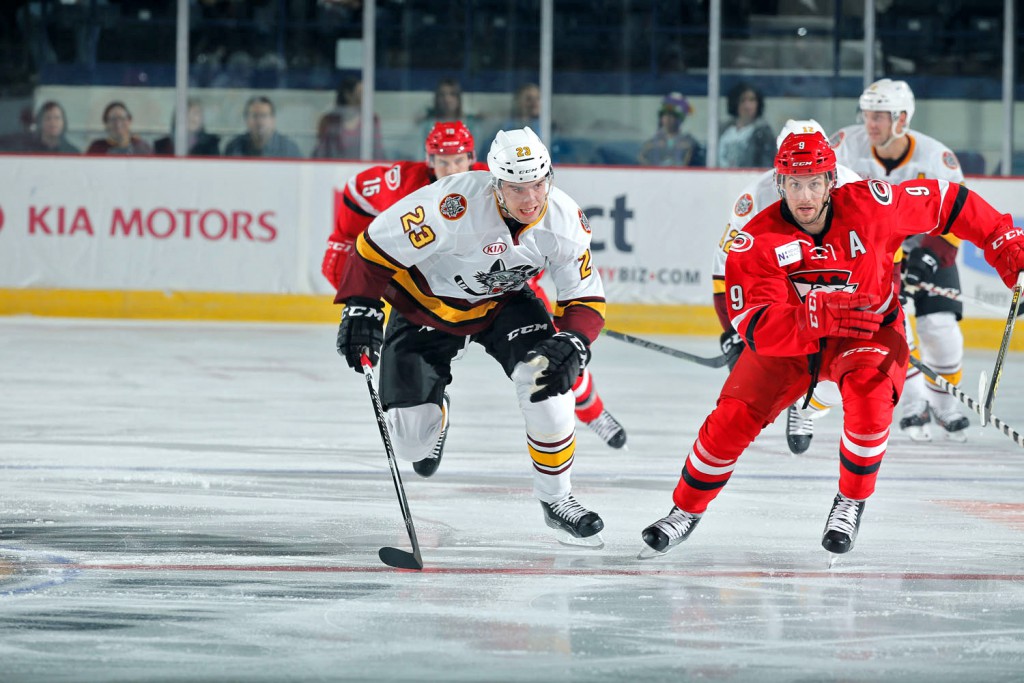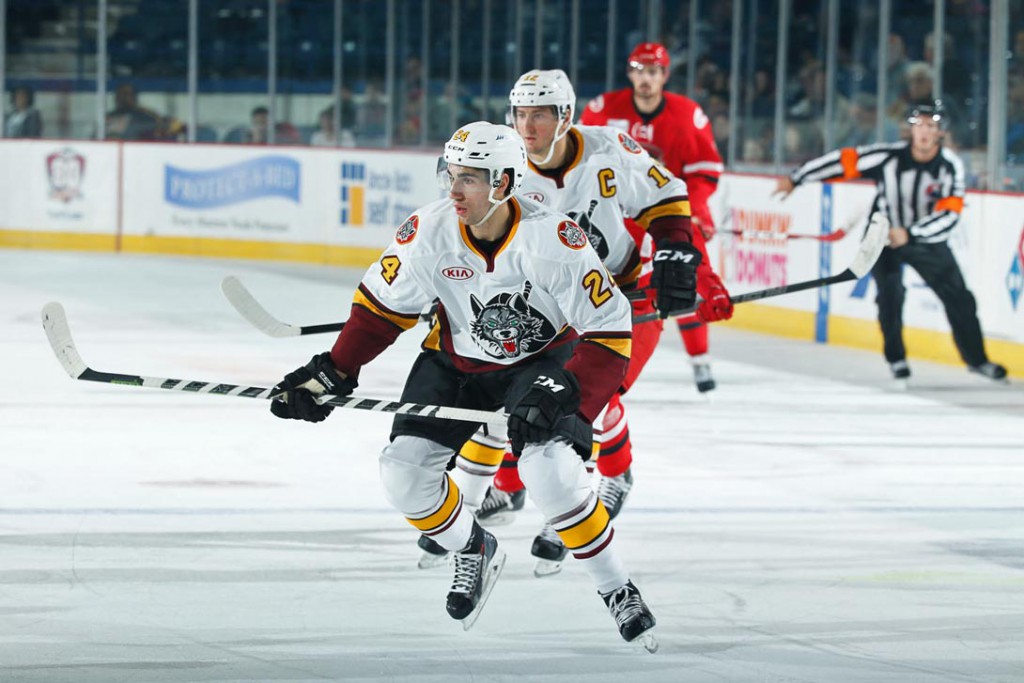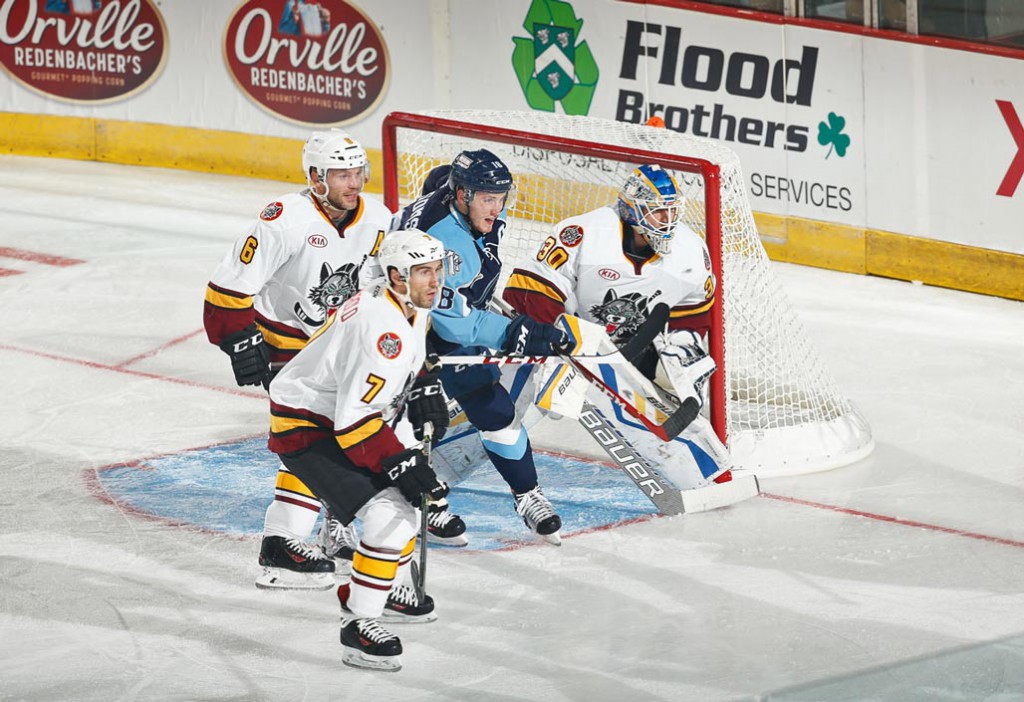By Nick Zazulia
If you are a professional hockey player assigned to an NHL team’s minor-league affiliate, such as the St. Louis Blues’ AHL partner, the Chicago Wolves, your all-encompassing goal is to get called up to the Blues and win a million Stanley Cups.
Obviously.
That nature of an AHL team means a lot of rather different individuals share that goal, from fresh rookies to grizzled veterans, international teenagers to thirty-something married Americans.
While the Wolves meld these various parts into a cohesive and winning team, players at various stages of their careers get different things out of their time in the AHL.
Four such players talked about their priorities, what they look for in a team and how they see their roles on the Wolves.

The former top prospect
Magnus Pääjärvi, 24, is in a good spot. The Blues called up the left winger Nov. 4. He has since played 15 games for St. Louis, scoring three points, with assistant general manager Kevin McDonald calling him a “full-time player.”
Pääjärvi took a circuitous route to get to that point. After being drafted 10th overall by the Edmonton Oilers in 2010, playing 80 games and scoring 34 points for them that season, Pääjärvi was seen as a star in the making.
His career hit a series of bumps from there, though, and he has spent large portions of each season since in the AHL. He was traded along with a second-round draft pick to the Blues for David Perron before the 2014 season. Since then, he played primarily with the Wolves until his promotion. Despite that, he kept his mind on his goal.
“I’m not focusing on the AHL team,” Pääjärvi said before his promotion. “My goal is to play on the NHL team. I want to play, and I’ve shown I can. The situation is, I’m down here now. But when signing a contract, I’m completely focused on the NHL team.”
Related Stories
• Chicago Wolves: The farm team that reaps what it sows
• Copley carries Wolves to second win over Moose
• Jake Chelios sees to make a name for himself with Wolves
• Wolves Wish program makes a difference for needy families
• Affordable tickets, quality hockey a winning combo for Wolves
Pääjärvi said he tried to be a leader while in the AHL. Even though he’s still young, he’s in his sixth season since entering the NHL and has experienced contract arbitration, a new organization and a second contract. Pääjärvi said he’s aware that the newer players pay attention to what the more experienced guys do.
“I try to take responsibility, be a good player, a leader on the ice and in the small details, the system,” he said. “There is logic to it, and young players pay attention.”
Pääjärvi said his focus was on what he could control. He wasn’t concerned with how the AHL team did business as long as the system facilitated transitions.
“It should be the same (style of play) in the AHL versus NHL (affiliates),” Pääjärvi said. “If it isn’t, that’s a problem.”
With that box checked, Pääjärvi knew what he needed to do.
“Doing the right things during games will get you up,” said Pääjärvi, who is listed at 6 feet 3, 208 pounds. “I know what I have to do: get into more battles and win them. I win more than I used to, but I can win more.”

Bubble boy
A guy still waiting for a real shot in the NHL is 27-year-old defensemen Eriah Hayes. He signed as an undrafted free agent with the San Jose Sharks after four years at Minnesota State University. He played 19 games for San Jose, but spent most of his time with its Worcester affiliate.
This past offseason, he signed with the Wolves. That they, rather than the Blues, hold his contract means he is free to sign with an NHL team at any time.
So why the Wolves?
“Chicago is a great organization, it’s centrally located, there are a lot of eyes on you every night,” Hayes said. “This is a very professional organization. They treat you very well.”
That’s really what it comes down to for Hayes: being seen exhibiting good, professional habits in a good, professional environment.
“I want to approach every game that way, especially being a bubble guy,” said Hayes, who has a goal, an assist and 20 penalty minutes in 10 games. “Focusing on every shift, trying to earn a spot. They don’t ask you to do different things down here — third-liners do what third-liners do, goal-scorers score goals, etc. If you do the right things down here, things are going to work for you up there.”
As for his off-ice role, Hayes is in an odd spot. Twenty-seven is trending toward old for an AHL player, but because of his path, he’s not very seasoned.
“You’re only as old as you think you are,” Hayes said. “I’m a third-year pro.”
But if his age doesn’t distinguish him in the locker room, something else does: his new wedding ring.
“I usually do try to set an example as a team leader because when I wasn’t married I’d look at the married guys and think they had been around,” Hayes said.

The hot new prospect
Five years Hayes’ junior with an unadorned ring finger and just a couple of months of professional experience after three years at the University of North Dakota is fellow defenseman Jordan Schmaltz. Drafted 25th overall in 2012, he is considered to be one of the Blues’ top prospects.
“After you get drafted and go to the camp, you’re on a high, but then you’re put back in place (pretty quickly once practices start,)” Schmaltz said.
Schmaltz says now that he’s in Chicago, he’s just another young player trying to earn ice time and learn from the veterans, particularly fellow defensemen who have spent time in the NHL such as Andre Benoit and Peter Harrold.
There’s been an adjustment, though. The way guys take care of their bodies and prepare every day is significantly different between college and the pros, according to Schmaltz.
Team composition is another change. This is the first time Schmaltz has played with guys who are more than a decade older than he is.
“The age difference is kind of weird at first, but if anything, all hockey players make mostly the same jokes,” which helps to minimize the disparity, Schmaltz said.
Going forward, Schmaltz feels like the Blues and Wolves are on the same page about where he needs to improve.
“I’m never going to be a guy who is laying a ton of big hits, but I can be a bit more physical to round out my game,” said the 6-foot-2, 190-pound Schmaltz, who has one goal and nine assists. “(That said,) anytime you can play to your strengths, it’s what you want to do.”

The seasoned prospect
Goalie Jordan Binnington is 22, same as Schmaltz. The Blues took him in the third round of the 2011 draft, one year before Schmaltz. Unlike Schmaltz, Binnington chose the junior hockey route over college. He has been playing professionally since the end of the 2011-2012 season, coming out of Canada’s major junior Ontario Hockey League before that.
“The dream for most guys and me personally is to play in the NHL,” Binnington said. “Saying that, it’s also nice to have a team for a whole season you work with and go through ups and downs and with. (Not always having that is) the tough part about pro hockey.”
Binnington (6-3-2, 2.51 goals-against average, .908 save percentage) is the Wolves’ starter, making him the presumptive first in line for a call-up to the Blues, though he does cede almost half the team’s games to 23-year-old Pheonix Copley, for whom St. Louis traded in the offseason.
Binnington had a similar role last season, when he also split time in goal, but he started all of their playoff games. He went 25-15-4 with a 2.35 goals-against average and .916 save percentage during the regular season.
He says he’s fine with that role for now.
“At the point in my career,” said Binnington, “I think it’s better to be getting in as many games as possible.”
The reason Binnington wants those games is to give himself more time to adjust to stopping high-level shots.
“The technique part of it, most goalies at this level have down what works for them, so it’s read and react,” Binnington said. The difference for goalies at the highest levels of hockey is “shot placement and velocity. The puck is coming off [a shooter’s] stick faster, so you have to get used to that.”
And while some things can be studied and picked up on video, the reading and reacting can only be honed from repetitions against great shooters. Even practice can be tough, because Binnington says most of the drills aren’t really set up for the benefit of goalies. That’s why he wants to get in as many games as he can, even if they’re AHL games for now.
Not that he would complain if he got promoted, that is. There would be things to like about that.
“Getting the NHL paycheck would be pretty nice.”


